IFN661 - Mobile and Pervasive Systems: 5G vs LoRaWAN IoT Networks
VerifiedAdded on 2023/01/17
|10
|3100
|61
Report
AI Summary
This research paper, prepared for IFN661 - Mobile and Pervasive Systems, provides a comprehensive analysis of wireless IoT networks, specifically comparing 5G and LoRaWAN technologies. The report begins with an introduction to LPWAN and its significance in IoT applications, followed by a literature review that explores the functionalities of LoRaWAN, its integration with 5G networks, and network architectures. A case study analysis then contrasts the two technologies, highlighting their strengths and weaknesses in various IoT scenarios. The paper further examines the application of these technologies in different domains, such as homes, manufacturing plants, and smart city infrastructures. Finally, the report concludes with recommendations for stakeholders, emphasizing the benefits of IoT in communication, automation control, monitoring, and cost savings, summarizing the potential of both 5G and LoRaWAN in the evolving IoT market. The report is structured to provide a clear understanding of the design challenges and opportunities in wireless IoT networks.
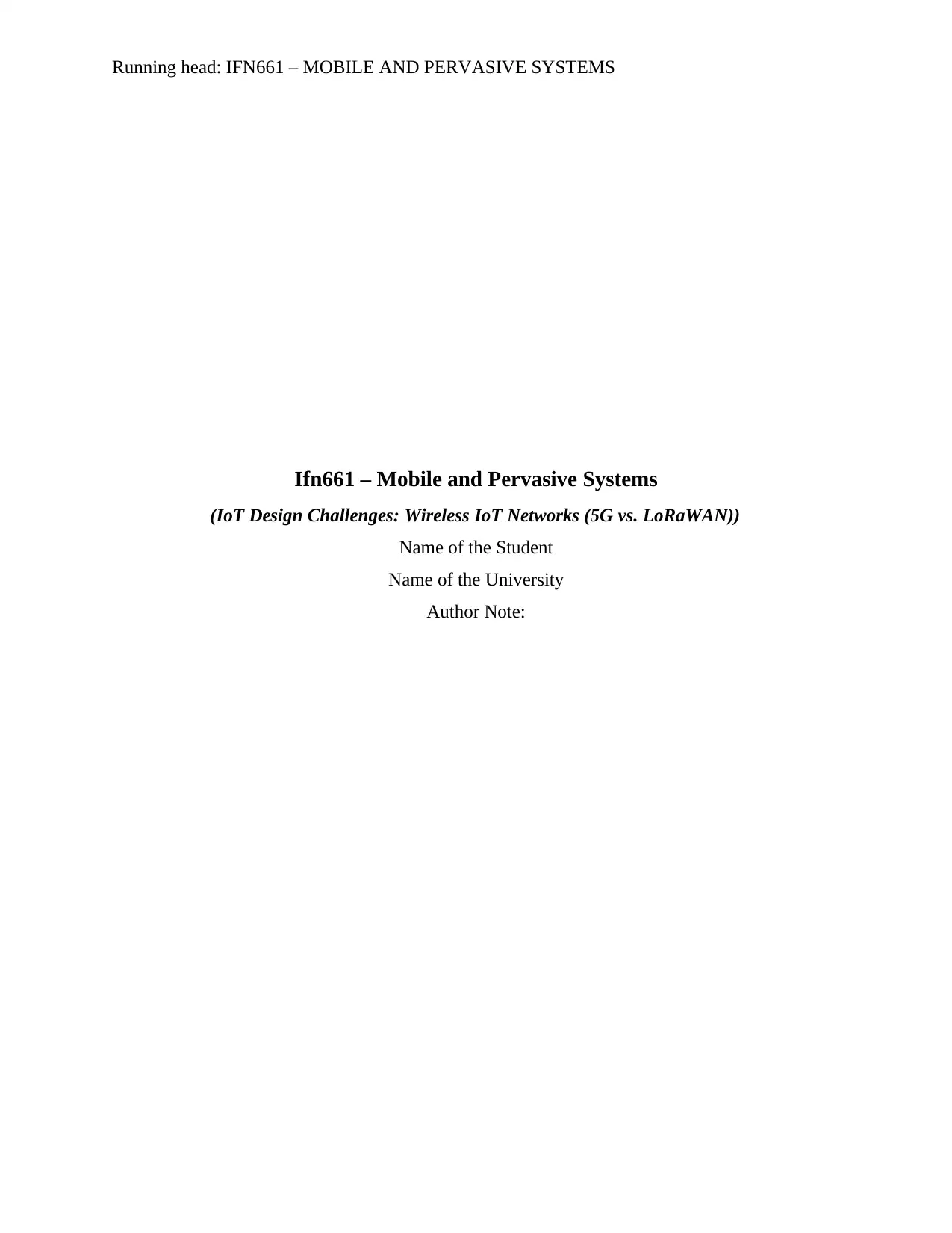
Running head: IFN661 – MOBILE AND PERVASIVE SYSTEMS
Ifn661 – Mobile and Pervasive Systems
(IoT Design Challenges: Wireless IoT Networks (5G vs. LoRaWAN))
Name of the Student
Name of the University
Author Note:
Ifn661 – Mobile and Pervasive Systems
(IoT Design Challenges: Wireless IoT Networks (5G vs. LoRaWAN))
Name of the Student
Name of the University
Author Note:
Paraphrase This Document
Need a fresh take? Get an instant paraphrase of this document with our AI Paraphraser
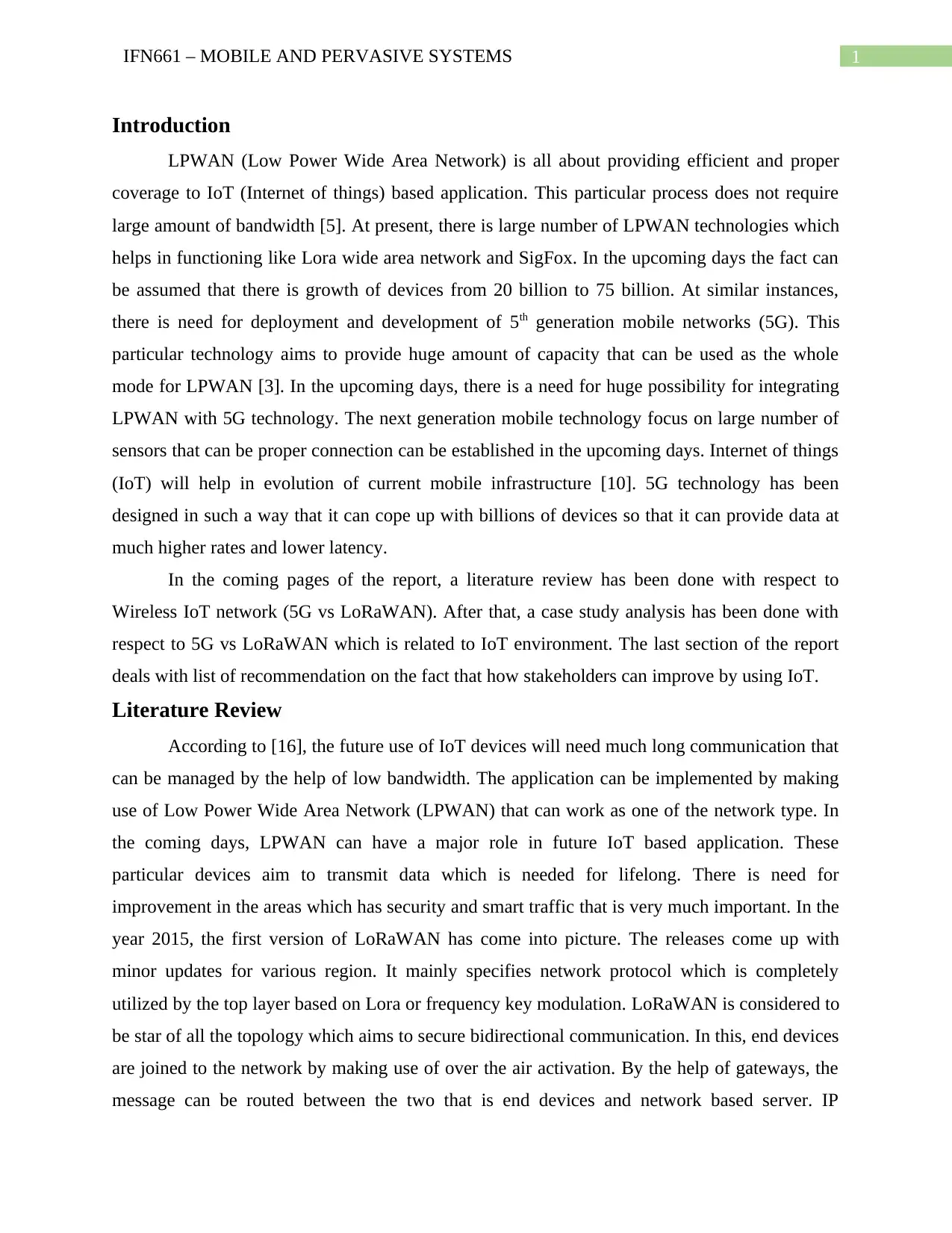
1IFN661 – MOBILE AND PERVASIVE SYSTEMS
Introduction
LPWAN (Low Power Wide Area Network) is all about providing efficient and proper
coverage to IoT (Internet of things) based application. This particular process does not require
large amount of bandwidth [5]. At present, there is large number of LPWAN technologies which
helps in functioning like Lora wide area network and SigFox. In the upcoming days the fact can
be assumed that there is growth of devices from 20 billion to 75 billion. At similar instances,
there is need for deployment and development of 5th generation mobile networks (5G). This
particular technology aims to provide huge amount of capacity that can be used as the whole
mode for LPWAN [3]. In the upcoming days, there is a need for huge possibility for integrating
LPWAN with 5G technology. The next generation mobile technology focus on large number of
sensors that can be proper connection can be established in the upcoming days. Internet of things
(IoT) will help in evolution of current mobile infrastructure [10]. 5G technology has been
designed in such a way that it can cope up with billions of devices so that it can provide data at
much higher rates and lower latency.
In the coming pages of the report, a literature review has been done with respect to
Wireless IoT network (5G vs LoRaWAN). After that, a case study analysis has been done with
respect to 5G vs LoRaWAN which is related to IoT environment. The last section of the report
deals with list of recommendation on the fact that how stakeholders can improve by using IoT.
Literature Review
According to [16], the future use of IoT devices will need much long communication that
can be managed by the help of low bandwidth. The application can be implemented by making
use of Low Power Wide Area Network (LPWAN) that can work as one of the network type. In
the coming days, LPWAN can have a major role in future IoT based application. These
particular devices aim to transmit data which is needed for lifelong. There is need for
improvement in the areas which has security and smart traffic that is very much important. In the
year 2015, the first version of LoRaWAN has come into picture. The releases come up with
minor updates for various region. It mainly specifies network protocol which is completely
utilized by the top layer based on Lora or frequency key modulation. LoRaWAN is considered to
be star of all the topology which aims to secure bidirectional communication. In this, end devices
are joined to the network by making use of over the air activation. By the help of gateways, the
message can be routed between the two that is end devices and network based server. IP
Introduction
LPWAN (Low Power Wide Area Network) is all about providing efficient and proper
coverage to IoT (Internet of things) based application. This particular process does not require
large amount of bandwidth [5]. At present, there is large number of LPWAN technologies which
helps in functioning like Lora wide area network and SigFox. In the upcoming days the fact can
be assumed that there is growth of devices from 20 billion to 75 billion. At similar instances,
there is need for deployment and development of 5th generation mobile networks (5G). This
particular technology aims to provide huge amount of capacity that can be used as the whole
mode for LPWAN [3]. In the upcoming days, there is a need for huge possibility for integrating
LPWAN with 5G technology. The next generation mobile technology focus on large number of
sensors that can be proper connection can be established in the upcoming days. Internet of things
(IoT) will help in evolution of current mobile infrastructure [10]. 5G technology has been
designed in such a way that it can cope up with billions of devices so that it can provide data at
much higher rates and lower latency.
In the coming pages of the report, a literature review has been done with respect to
Wireless IoT network (5G vs LoRaWAN). After that, a case study analysis has been done with
respect to 5G vs LoRaWAN which is related to IoT environment. The last section of the report
deals with list of recommendation on the fact that how stakeholders can improve by using IoT.
Literature Review
According to [16], the future use of IoT devices will need much long communication that
can be managed by the help of low bandwidth. The application can be implemented by making
use of Low Power Wide Area Network (LPWAN) that can work as one of the network type. In
the coming days, LPWAN can have a major role in future IoT based application. These
particular devices aim to transmit data which is needed for lifelong. There is need for
improvement in the areas which has security and smart traffic that is very much important. In the
year 2015, the first version of LoRaWAN has come into picture. The releases come up with
minor updates for various region. It mainly specifies network protocol which is completely
utilized by the top layer based on Lora or frequency key modulation. LoRaWAN is considered to
be star of all the topology which aims to secure bidirectional communication. In this, end devices
are joined to the network by making use of over the air activation. By the help of gateways, the
message can be routed between the two that is end devices and network based server. IP
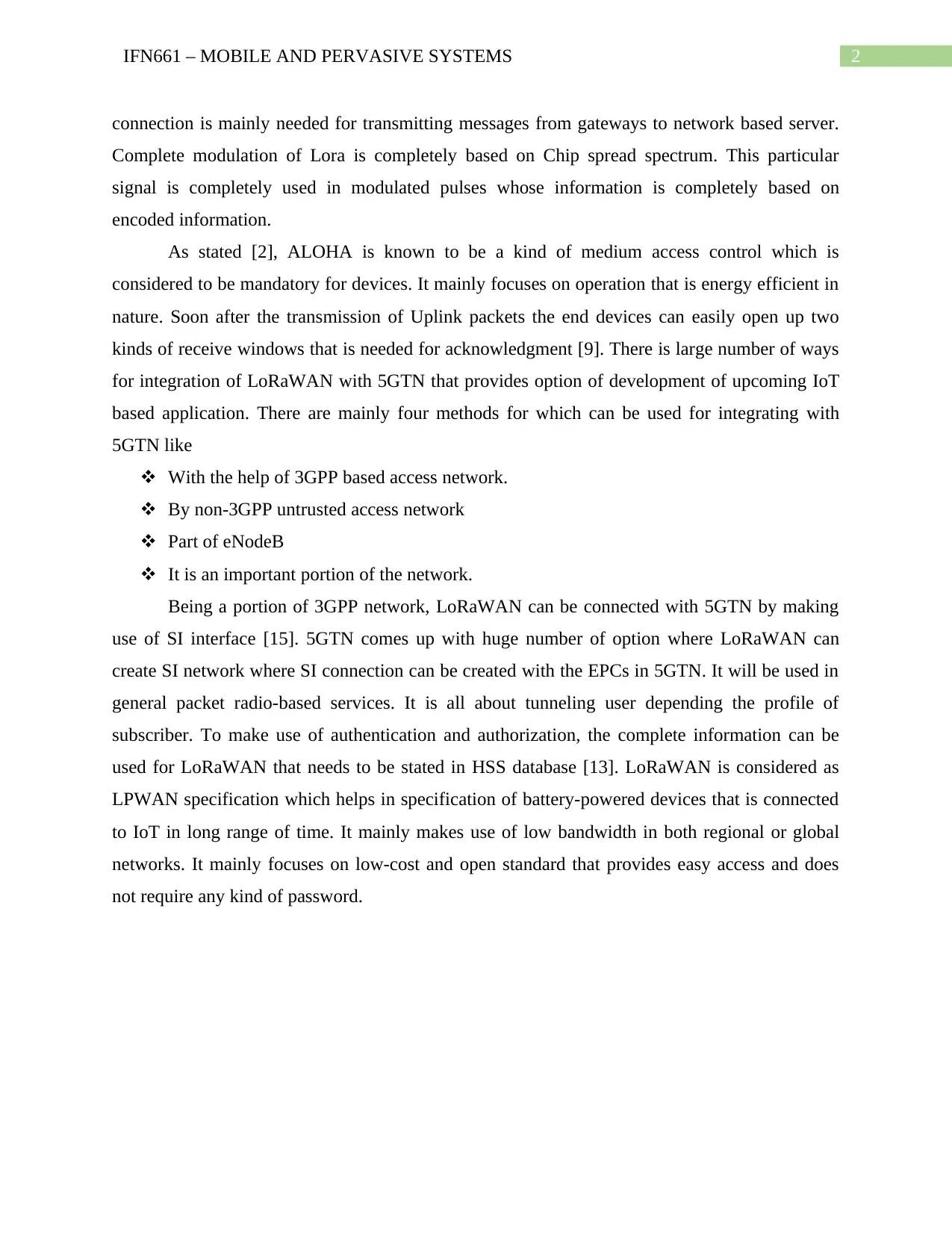
2IFN661 – MOBILE AND PERVASIVE SYSTEMS
connection is mainly needed for transmitting messages from gateways to network based server.
Complete modulation of Lora is completely based on Chip spread spectrum. This particular
signal is completely used in modulated pulses whose information is completely based on
encoded information.
As stated [2], ALOHA is known to be a kind of medium access control which is
considered to be mandatory for devices. It mainly focuses on operation that is energy efficient in
nature. Soon after the transmission of Uplink packets the end devices can easily open up two
kinds of receive windows that is needed for acknowledgment [9]. There is large number of ways
for integration of LoRaWAN with 5GTN that provides option of development of upcoming IoT
based application. There are mainly four methods for which can be used for integrating with
5GTN like
With the help of 3GPP based access network.
By non-3GPP untrusted access network
Part of eNodeB
It is an important portion of the network.
Being a portion of 3GPP network, LoRaWAN can be connected with 5GTN by making
use of SI interface [15]. 5GTN comes up with huge number of option where LoRaWAN can
create SI network where SI connection can be created with the EPCs in 5GTN. It will be used in
general packet radio-based services. It is all about tunneling user depending the profile of
subscriber. To make use of authentication and authorization, the complete information can be
used for LoRaWAN that needs to be stated in HSS database [13]. LoRaWAN is considered as
LPWAN specification which helps in specification of battery-powered devices that is connected
to IoT in long range of time. It mainly makes use of low bandwidth in both regional or global
networks. It mainly focuses on low-cost and open standard that provides easy access and does
not require any kind of password.
connection is mainly needed for transmitting messages from gateways to network based server.
Complete modulation of Lora is completely based on Chip spread spectrum. This particular
signal is completely used in modulated pulses whose information is completely based on
encoded information.
As stated [2], ALOHA is known to be a kind of medium access control which is
considered to be mandatory for devices. It mainly focuses on operation that is energy efficient in
nature. Soon after the transmission of Uplink packets the end devices can easily open up two
kinds of receive windows that is needed for acknowledgment [9]. There is large number of ways
for integration of LoRaWAN with 5GTN that provides option of development of upcoming IoT
based application. There are mainly four methods for which can be used for integrating with
5GTN like
With the help of 3GPP based access network.
By non-3GPP untrusted access network
Part of eNodeB
It is an important portion of the network.
Being a portion of 3GPP network, LoRaWAN can be connected with 5GTN by making
use of SI interface [15]. 5GTN comes up with huge number of option where LoRaWAN can
create SI network where SI connection can be created with the EPCs in 5GTN. It will be used in
general packet radio-based services. It is all about tunneling user depending the profile of
subscriber. To make use of authentication and authorization, the complete information can be
used for LoRaWAN that needs to be stated in HSS database [13]. LoRaWAN is considered as
LPWAN specification which helps in specification of battery-powered devices that is connected
to IoT in long range of time. It mainly makes use of low bandwidth in both regional or global
networks. It mainly focuses on low-cost and open standard that provides easy access and does
not require any kind of password.
⊘ This is a preview!⊘
Do you want full access?
Subscribe today to unlock all pages.

Trusted by 1+ million students worldwide
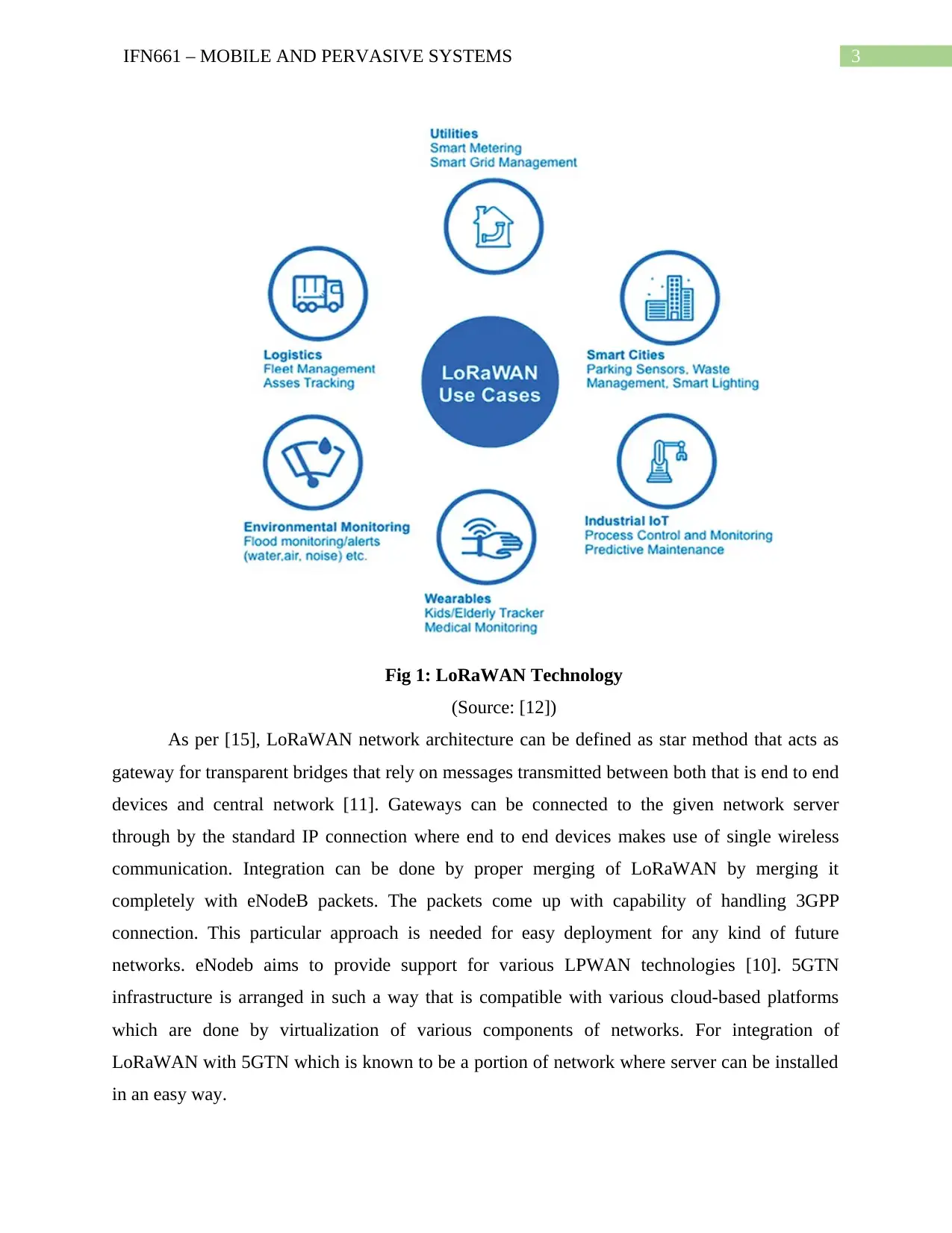
3IFN661 – MOBILE AND PERVASIVE SYSTEMS
Fig 1: LoRaWAN Technology
(Source: [12])
As per [15], LoRaWAN network architecture can be defined as star method that acts as
gateway for transparent bridges that rely on messages transmitted between both that is end to end
devices and central network [11]. Gateways can be connected to the given network server
through by the standard IP connection where end to end devices makes use of single wireless
communication. Integration can be done by proper merging of LoRaWAN by merging it
completely with eNodeB packets. The packets come up with capability of handling 3GPP
connection. This particular approach is needed for easy deployment for any kind of future
networks. eNodeb aims to provide support for various LPWAN technologies [10]. 5GTN
infrastructure is arranged in such a way that is compatible with various cloud-based platforms
which are done by virtualization of various components of networks. For integration of
LoRaWAN with 5GTN which is known to be a portion of network where server can be installed
in an easy way.
Fig 1: LoRaWAN Technology
(Source: [12])
As per [15], LoRaWAN network architecture can be defined as star method that acts as
gateway for transparent bridges that rely on messages transmitted between both that is end to end
devices and central network [11]. Gateways can be connected to the given network server
through by the standard IP connection where end to end devices makes use of single wireless
communication. Integration can be done by proper merging of LoRaWAN by merging it
completely with eNodeB packets. The packets come up with capability of handling 3GPP
connection. This particular approach is needed for easy deployment for any kind of future
networks. eNodeb aims to provide support for various LPWAN technologies [10]. 5GTN
infrastructure is arranged in such a way that is compatible with various cloud-based platforms
which are done by virtualization of various components of networks. For integration of
LoRaWAN with 5GTN which is known to be a portion of network where server can be installed
in an easy way.
Paraphrase This Document
Need a fresh take? Get an instant paraphrase of this document with our AI Paraphraser
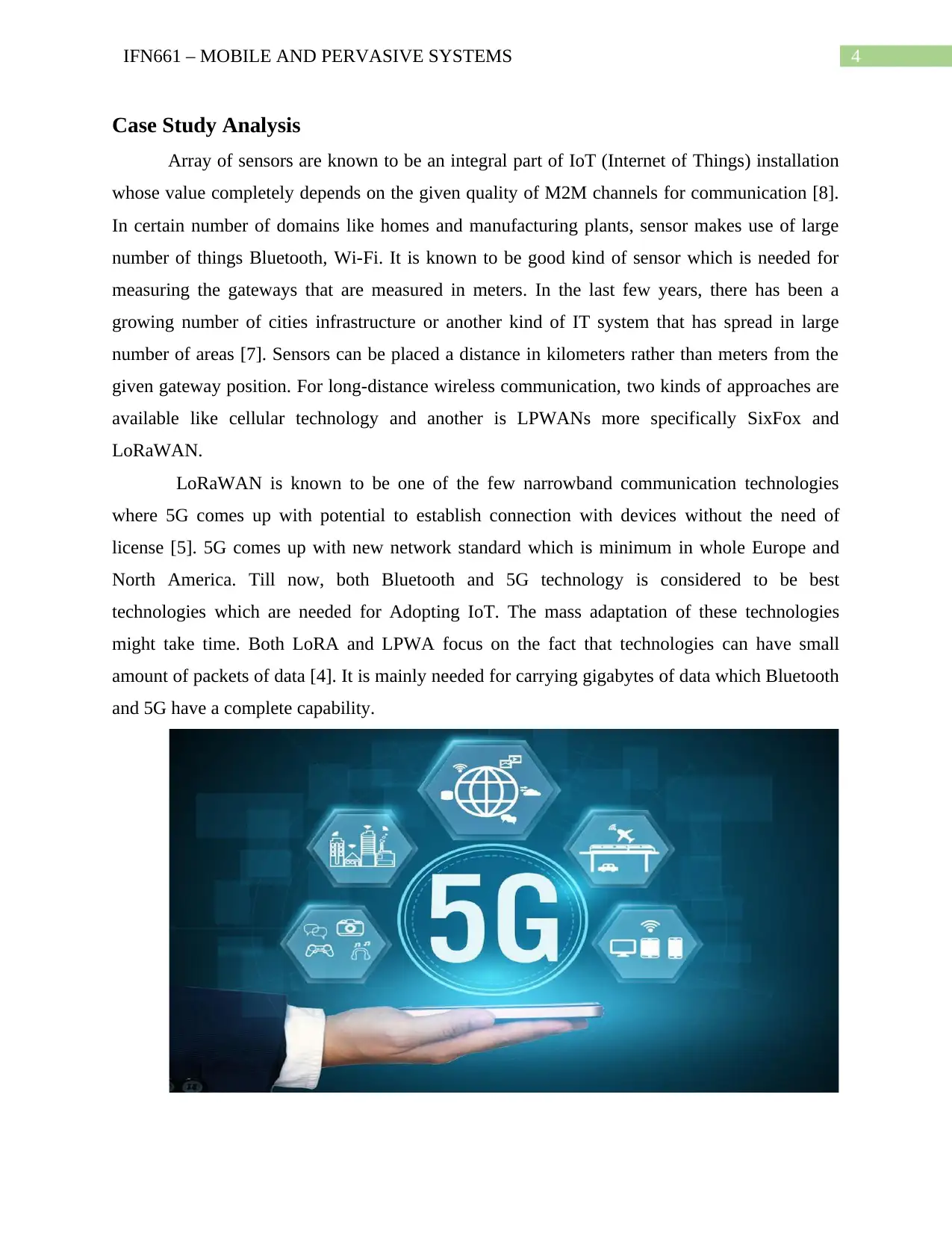
4IFN661 – MOBILE AND PERVASIVE SYSTEMS
Case Study Analysis
Array of sensors are known to be an integral part of IoT (Internet of Things) installation
whose value completely depends on the given quality of M2M channels for communication [8].
In certain number of domains like homes and manufacturing plants, sensor makes use of large
number of things Bluetooth, Wi-Fi. It is known to be good kind of sensor which is needed for
measuring the gateways that are measured in meters. In the last few years, there has been a
growing number of cities infrastructure or another kind of IT system that has spread in large
number of areas [7]. Sensors can be placed a distance in kilometers rather than meters from the
given gateway position. For long-distance wireless communication, two kinds of approaches are
available like cellular technology and another is LPWANs more specifically SixFox and
LoRaWAN.
LoRaWAN is known to be one of the few narrowband communication technologies
where 5G comes up with potential to establish connection with devices without the need of
license [5]. 5G comes up with new network standard which is minimum in whole Europe and
North America. Till now, both Bluetooth and 5G technology is considered to be best
technologies which are needed for Adopting IoT. The mass adaptation of these technologies
might take time. Both LoRA and LPWA focus on the fact that technologies can have small
amount of packets of data [4]. It is mainly needed for carrying gigabytes of data which Bluetooth
and 5G have a complete capability.
Case Study Analysis
Array of sensors are known to be an integral part of IoT (Internet of Things) installation
whose value completely depends on the given quality of M2M channels for communication [8].
In certain number of domains like homes and manufacturing plants, sensor makes use of large
number of things Bluetooth, Wi-Fi. It is known to be good kind of sensor which is needed for
measuring the gateways that are measured in meters. In the last few years, there has been a
growing number of cities infrastructure or another kind of IT system that has spread in large
number of areas [7]. Sensors can be placed a distance in kilometers rather than meters from the
given gateway position. For long-distance wireless communication, two kinds of approaches are
available like cellular technology and another is LPWANs more specifically SixFox and
LoRaWAN.
LoRaWAN is known to be one of the few narrowband communication technologies
where 5G comes up with potential to establish connection with devices without the need of
license [5]. 5G comes up with new network standard which is minimum in whole Europe and
North America. Till now, both Bluetooth and 5G technology is considered to be best
technologies which are needed for Adopting IoT. The mass adaptation of these technologies
might take time. Both LoRA and LPWA focus on the fact that technologies can have small
amount of packets of data [4]. It is mainly needed for carrying gigabytes of data which Bluetooth
and 5G have a complete capability.
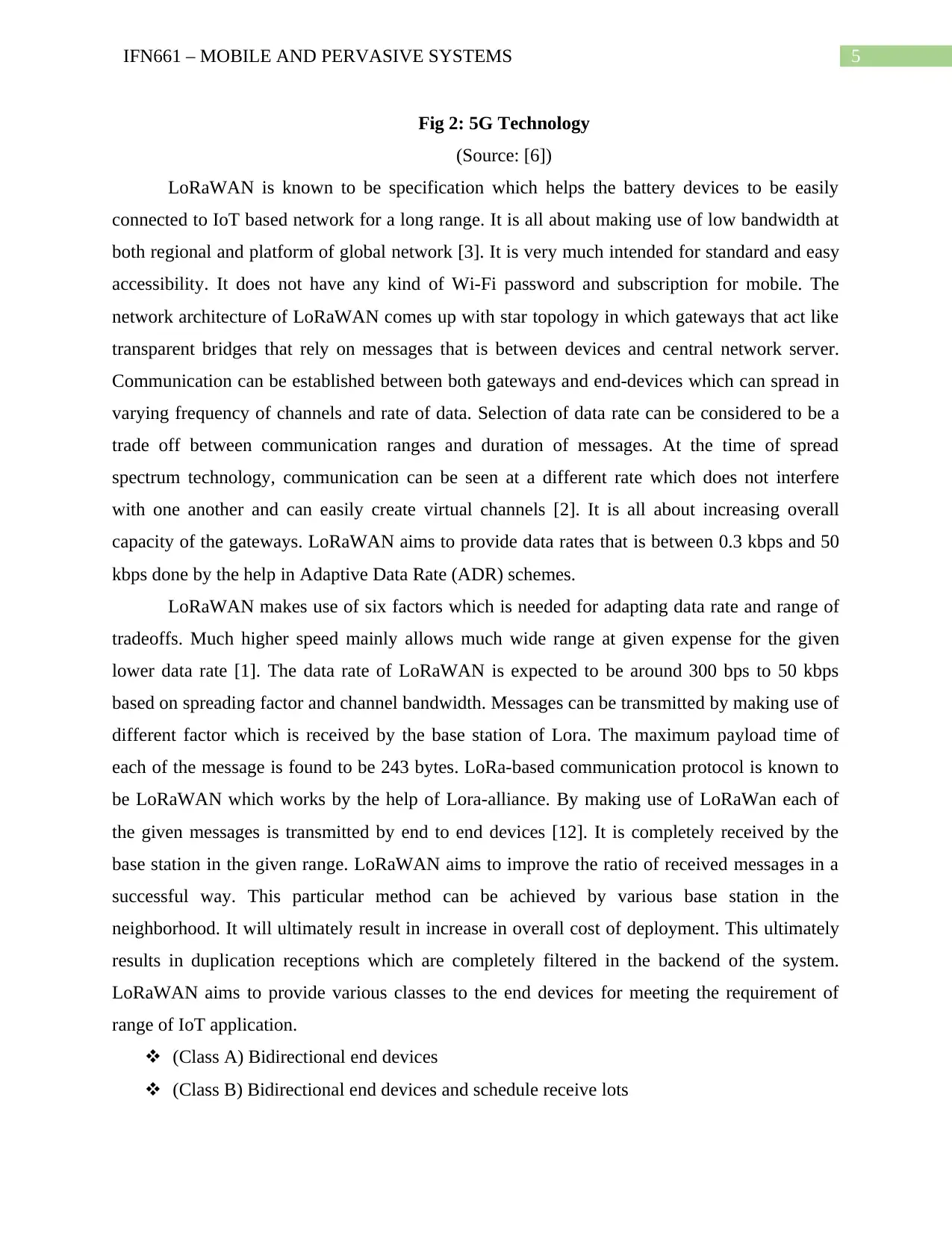
5IFN661 – MOBILE AND PERVASIVE SYSTEMS
Fig 2: 5G Technology
(Source: [6])
LoRaWAN is known to be specification which helps the battery devices to be easily
connected to IoT based network for a long range. It is all about making use of low bandwidth at
both regional and platform of global network [3]. It is very much intended for standard and easy
accessibility. It does not have any kind of Wi-Fi password and subscription for mobile. The
network architecture of LoRaWAN comes up with star topology in which gateways that act like
transparent bridges that rely on messages that is between devices and central network server.
Communication can be established between both gateways and end-devices which can spread in
varying frequency of channels and rate of data. Selection of data rate can be considered to be a
trade off between communication ranges and duration of messages. At the time of spread
spectrum technology, communication can be seen at a different rate which does not interfere
with one another and can easily create virtual channels [2]. It is all about increasing overall
capacity of the gateways. LoRaWAN aims to provide data rates that is between 0.3 kbps and 50
kbps done by the help in Adaptive Data Rate (ADR) schemes.
LoRaWAN makes use of six factors which is needed for adapting data rate and range of
tradeoffs. Much higher speed mainly allows much wide range at given expense for the given
lower data rate [1]. The data rate of LoRaWAN is expected to be around 300 bps to 50 kbps
based on spreading factor and channel bandwidth. Messages can be transmitted by making use of
different factor which is received by the base station of Lora. The maximum payload time of
each of the message is found to be 243 bytes. LoRa-based communication protocol is known to
be LoRaWAN which works by the help of Lora-alliance. By making use of LoRaWan each of
the given messages is transmitted by end to end devices [12]. It is completely received by the
base station in the given range. LoRaWAN aims to improve the ratio of received messages in a
successful way. This particular method can be achieved by various base station in the
neighborhood. It will ultimately result in increase in overall cost of deployment. This ultimately
results in duplication receptions which are completely filtered in the backend of the system.
LoRaWAN aims to provide various classes to the end devices for meeting the requirement of
range of IoT application.
(Class A) Bidirectional end devices
(Class B) Bidirectional end devices and schedule receive lots
Fig 2: 5G Technology
(Source: [6])
LoRaWAN is known to be specification which helps the battery devices to be easily
connected to IoT based network for a long range. It is all about making use of low bandwidth at
both regional and platform of global network [3]. It is very much intended for standard and easy
accessibility. It does not have any kind of Wi-Fi password and subscription for mobile. The
network architecture of LoRaWAN comes up with star topology in which gateways that act like
transparent bridges that rely on messages that is between devices and central network server.
Communication can be established between both gateways and end-devices which can spread in
varying frequency of channels and rate of data. Selection of data rate can be considered to be a
trade off between communication ranges and duration of messages. At the time of spread
spectrum technology, communication can be seen at a different rate which does not interfere
with one another and can easily create virtual channels [2]. It is all about increasing overall
capacity of the gateways. LoRaWAN aims to provide data rates that is between 0.3 kbps and 50
kbps done by the help in Adaptive Data Rate (ADR) schemes.
LoRaWAN makes use of six factors which is needed for adapting data rate and range of
tradeoffs. Much higher speed mainly allows much wide range at given expense for the given
lower data rate [1]. The data rate of LoRaWAN is expected to be around 300 bps to 50 kbps
based on spreading factor and channel bandwidth. Messages can be transmitted by making use of
different factor which is received by the base station of Lora. The maximum payload time of
each of the message is found to be 243 bytes. LoRa-based communication protocol is known to
be LoRaWAN which works by the help of Lora-alliance. By making use of LoRaWan each of
the given messages is transmitted by end to end devices [12]. It is completely received by the
base station in the given range. LoRaWAN aims to improve the ratio of received messages in a
successful way. This particular method can be achieved by various base station in the
neighborhood. It will ultimately result in increase in overall cost of deployment. This ultimately
results in duplication receptions which are completely filtered in the backend of the system.
LoRaWAN aims to provide various classes to the end devices for meeting the requirement of
range of IoT application.
(Class A) Bidirectional end devices
(Class B) Bidirectional end devices and schedule receive lots
⊘ This is a preview!⊘
Do you want full access?
Subscribe today to unlock all pages.

Trusted by 1+ million students worldwide
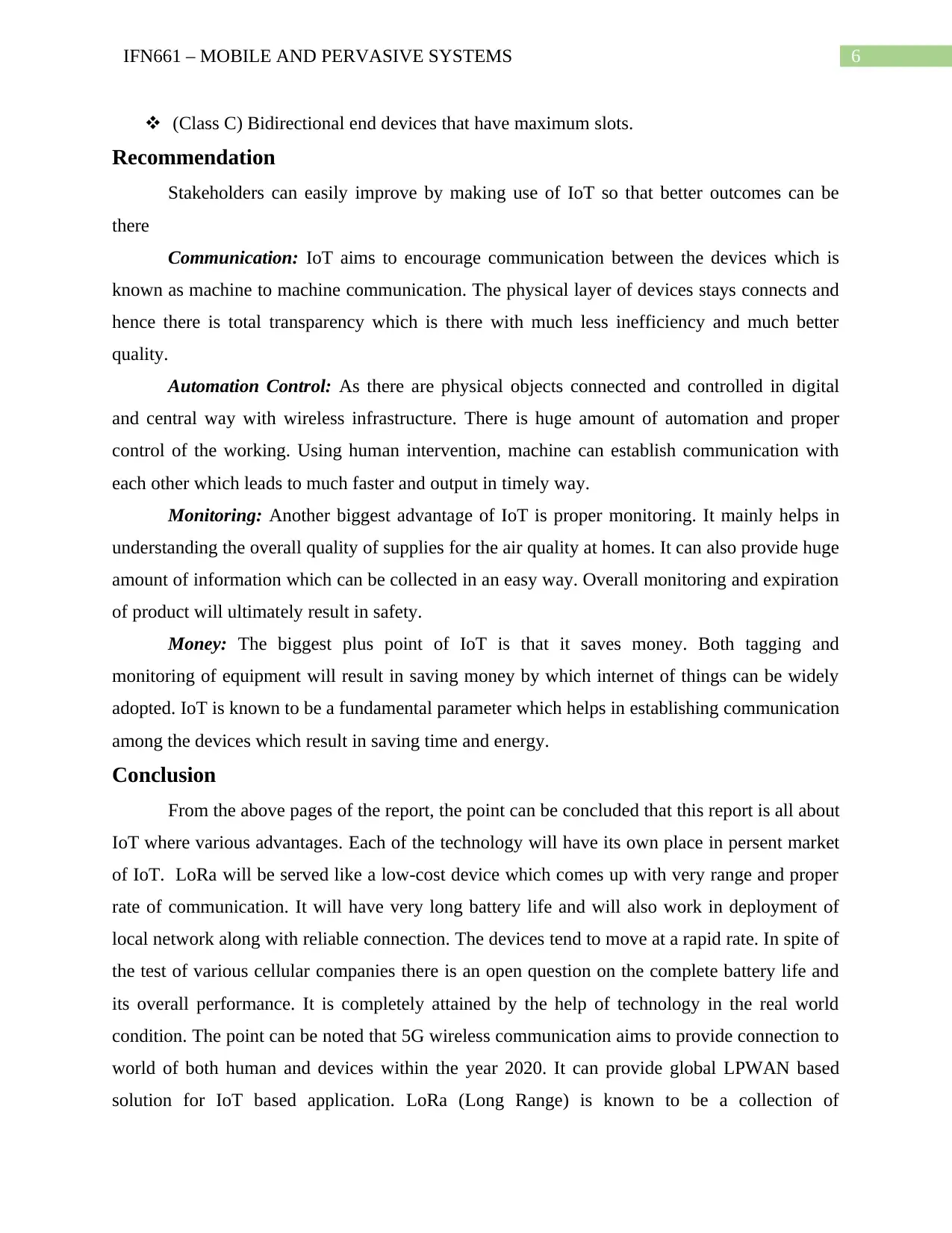
6IFN661 – MOBILE AND PERVASIVE SYSTEMS
(Class C) Bidirectional end devices that have maximum slots.
Recommendation
Stakeholders can easily improve by making use of IoT so that better outcomes can be
there
Communication: IoT aims to encourage communication between the devices which is
known as machine to machine communication. The physical layer of devices stays connects and
hence there is total transparency which is there with much less inefficiency and much better
quality.
Automation Control: As there are physical objects connected and controlled in digital
and central way with wireless infrastructure. There is huge amount of automation and proper
control of the working. Using human intervention, machine can establish communication with
each other which leads to much faster and output in timely way.
Monitoring: Another biggest advantage of IoT is proper monitoring. It mainly helps in
understanding the overall quality of supplies for the air quality at homes. It can also provide huge
amount of information which can be collected in an easy way. Overall monitoring and expiration
of product will ultimately result in safety.
Money: The biggest plus point of IoT is that it saves money. Both tagging and
monitoring of equipment will result in saving money by which internet of things can be widely
adopted. IoT is known to be a fundamental parameter which helps in establishing communication
among the devices which result in saving time and energy.
Conclusion
From the above pages of the report, the point can be concluded that this report is all about
IoT where various advantages. Each of the technology will have its own place in persent market
of IoT. LoRa will be served like a low-cost device which comes up with very range and proper
rate of communication. It will have very long battery life and will also work in deployment of
local network along with reliable connection. The devices tend to move at a rapid rate. In spite of
the test of various cellular companies there is an open question on the complete battery life and
its overall performance. It is completely attained by the help of technology in the real world
condition. The point can be noted that 5G wireless communication aims to provide connection to
world of both human and devices within the year 2020. It can provide global LPWAN based
solution for IoT based application. LoRa (Long Range) is known to be a collection of
(Class C) Bidirectional end devices that have maximum slots.
Recommendation
Stakeholders can easily improve by making use of IoT so that better outcomes can be
there
Communication: IoT aims to encourage communication between the devices which is
known as machine to machine communication. The physical layer of devices stays connects and
hence there is total transparency which is there with much less inefficiency and much better
quality.
Automation Control: As there are physical objects connected and controlled in digital
and central way with wireless infrastructure. There is huge amount of automation and proper
control of the working. Using human intervention, machine can establish communication with
each other which leads to much faster and output in timely way.
Monitoring: Another biggest advantage of IoT is proper monitoring. It mainly helps in
understanding the overall quality of supplies for the air quality at homes. It can also provide huge
amount of information which can be collected in an easy way. Overall monitoring and expiration
of product will ultimately result in safety.
Money: The biggest plus point of IoT is that it saves money. Both tagging and
monitoring of equipment will result in saving money by which internet of things can be widely
adopted. IoT is known to be a fundamental parameter which helps in establishing communication
among the devices which result in saving time and energy.
Conclusion
From the above pages of the report, the point can be concluded that this report is all about
IoT where various advantages. Each of the technology will have its own place in persent market
of IoT. LoRa will be served like a low-cost device which comes up with very range and proper
rate of communication. It will have very long battery life and will also work in deployment of
local network along with reliable connection. The devices tend to move at a rapid rate. In spite of
the test of various cellular companies there is an open question on the complete battery life and
its overall performance. It is completely attained by the help of technology in the real world
condition. The point can be noted that 5G wireless communication aims to provide connection to
world of both human and devices within the year 2020. It can provide global LPWAN based
solution for IoT based application. LoRa (Long Range) is known to be a collection of
Paraphrase This Document
Need a fresh take? Get an instant paraphrase of this document with our AI Paraphraser

7IFN661 – MOBILE AND PERVASIVE SYSTEMS
technologies which connects devices over the spectrum. Both 5G and Bluetooth which is needed
for possible technologies needed for IoT adoption.
technologies which connects devices over the spectrum. Both 5G and Bluetooth which is needed
for possible technologies needed for IoT adoption.
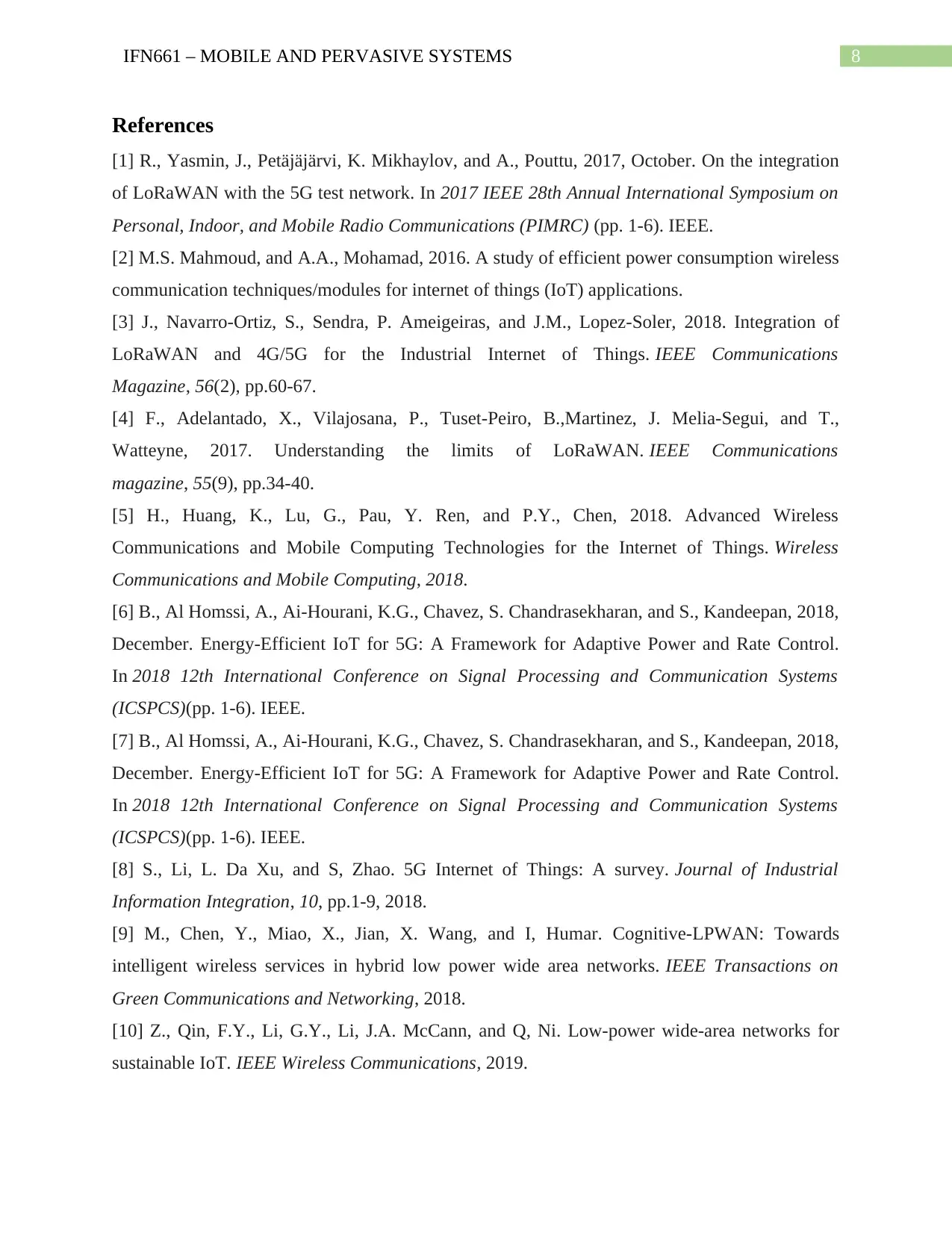
8IFN661 – MOBILE AND PERVASIVE SYSTEMS
References
[1] R., Yasmin, J., Petäjäjärvi, K. Mikhaylov, and A., Pouttu, 2017, October. On the integration
of LoRaWAN with the 5G test network. In 2017 IEEE 28th Annual International Symposium on
Personal, Indoor, and Mobile Radio Communications (PIMRC) (pp. 1-6). IEEE.
[2] M.S. Mahmoud, and A.A., Mohamad, 2016. A study of efficient power consumption wireless
communication techniques/modules for internet of things (IoT) applications.
[3] J., Navarro-Ortiz, S., Sendra, P. Ameigeiras, and J.M., Lopez-Soler, 2018. Integration of
LoRaWAN and 4G/5G for the Industrial Internet of Things. IEEE Communications
Magazine, 56(2), pp.60-67.
[4] F., Adelantado, X., Vilajosana, P., Tuset-Peiro, B.,Martinez, J. Melia-Segui, and T.,
Watteyne, 2017. Understanding the limits of LoRaWAN. IEEE Communications
magazine, 55(9), pp.34-40.
[5] H., Huang, K., Lu, G., Pau, Y. Ren, and P.Y., Chen, 2018. Advanced Wireless
Communications and Mobile Computing Technologies for the Internet of Things. Wireless
Communications and Mobile Computing, 2018.
[6] B., Al Homssi, A., Ai-Hourani, K.G., Chavez, S. Chandrasekharan, and S., Kandeepan, 2018,
December. Energy-Efficient IoT for 5G: A Framework for Adaptive Power and Rate Control.
In 2018 12th International Conference on Signal Processing and Communication Systems
(ICSPCS)(pp. 1-6). IEEE.
[7] B., Al Homssi, A., Ai-Hourani, K.G., Chavez, S. Chandrasekharan, and S., Kandeepan, 2018,
December. Energy-Efficient IoT for 5G: A Framework for Adaptive Power and Rate Control.
In 2018 12th International Conference on Signal Processing and Communication Systems
(ICSPCS)(pp. 1-6). IEEE.
[8] S., Li, L. Da Xu, and S, Zhao. 5G Internet of Things: A survey. Journal of Industrial
Information Integration, 10, pp.1-9, 2018.
[9] M., Chen, Y., Miao, X., Jian, X. Wang, and I, Humar. Cognitive-LPWAN: Towards
intelligent wireless services in hybrid low power wide area networks. IEEE Transactions on
Green Communications and Networking, 2018.
[10] Z., Qin, F.Y., Li, G.Y., Li, J.A. McCann, and Q, Ni. Low-power wide-area networks for
sustainable IoT. IEEE Wireless Communications, 2019.
References
[1] R., Yasmin, J., Petäjäjärvi, K. Mikhaylov, and A., Pouttu, 2017, October. On the integration
of LoRaWAN with the 5G test network. In 2017 IEEE 28th Annual International Symposium on
Personal, Indoor, and Mobile Radio Communications (PIMRC) (pp. 1-6). IEEE.
[2] M.S. Mahmoud, and A.A., Mohamad, 2016. A study of efficient power consumption wireless
communication techniques/modules for internet of things (IoT) applications.
[3] J., Navarro-Ortiz, S., Sendra, P. Ameigeiras, and J.M., Lopez-Soler, 2018. Integration of
LoRaWAN and 4G/5G for the Industrial Internet of Things. IEEE Communications
Magazine, 56(2), pp.60-67.
[4] F., Adelantado, X., Vilajosana, P., Tuset-Peiro, B.,Martinez, J. Melia-Segui, and T.,
Watteyne, 2017. Understanding the limits of LoRaWAN. IEEE Communications
magazine, 55(9), pp.34-40.
[5] H., Huang, K., Lu, G., Pau, Y. Ren, and P.Y., Chen, 2018. Advanced Wireless
Communications and Mobile Computing Technologies for the Internet of Things. Wireless
Communications and Mobile Computing, 2018.
[6] B., Al Homssi, A., Ai-Hourani, K.G., Chavez, S. Chandrasekharan, and S., Kandeepan, 2018,
December. Energy-Efficient IoT for 5G: A Framework for Adaptive Power and Rate Control.
In 2018 12th International Conference on Signal Processing and Communication Systems
(ICSPCS)(pp. 1-6). IEEE.
[7] B., Al Homssi, A., Ai-Hourani, K.G., Chavez, S. Chandrasekharan, and S., Kandeepan, 2018,
December. Energy-Efficient IoT for 5G: A Framework for Adaptive Power and Rate Control.
In 2018 12th International Conference on Signal Processing and Communication Systems
(ICSPCS)(pp. 1-6). IEEE.
[8] S., Li, L. Da Xu, and S, Zhao. 5G Internet of Things: A survey. Journal of Industrial
Information Integration, 10, pp.1-9, 2018.
[9] M., Chen, Y., Miao, X., Jian, X. Wang, and I, Humar. Cognitive-LPWAN: Towards
intelligent wireless services in hybrid low power wide area networks. IEEE Transactions on
Green Communications and Networking, 2018.
[10] Z., Qin, F.Y., Li, G.Y., Li, J.A. McCann, and Q, Ni. Low-power wide-area networks for
sustainable IoT. IEEE Wireless Communications, 2019.
⊘ This is a preview!⊘
Do you want full access?
Subscribe today to unlock all pages.

Trusted by 1+ million students worldwide
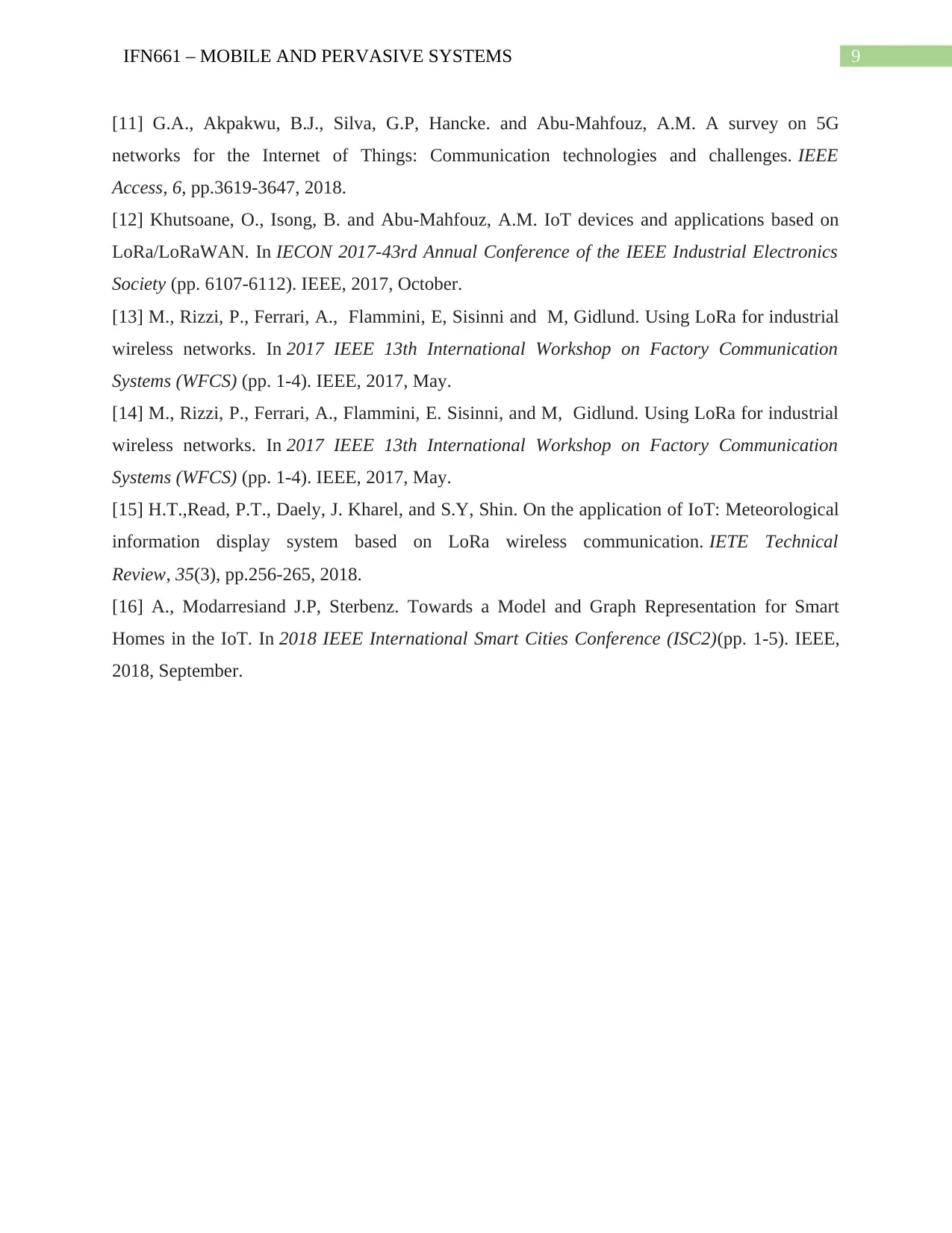
9IFN661 – MOBILE AND PERVASIVE SYSTEMS
[11] G.A., Akpakwu, B.J., Silva, G.P, Hancke. and Abu-Mahfouz, A.M. A survey on 5G
networks for the Internet of Things: Communication technologies and challenges. IEEE
Access, 6, pp.3619-3647, 2018.
[12] Khutsoane, O., Isong, B. and Abu-Mahfouz, A.M. IoT devices and applications based on
LoRa/LoRaWAN. In IECON 2017-43rd Annual Conference of the IEEE Industrial Electronics
Society (pp. 6107-6112). IEEE, 2017, October.
[13] M., Rizzi, P., Ferrari, A., Flammini, E, Sisinni and M, Gidlund. Using LoRa for industrial
wireless networks. In 2017 IEEE 13th International Workshop on Factory Communication
Systems (WFCS) (pp. 1-4). IEEE, 2017, May.
[14] M., Rizzi, P., Ferrari, A., Flammini, E. Sisinni, and M, Gidlund. Using LoRa for industrial
wireless networks. In 2017 IEEE 13th International Workshop on Factory Communication
Systems (WFCS) (pp. 1-4). IEEE, 2017, May.
[15] H.T.,Read, P.T., Daely, J. Kharel, and S.Y, Shin. On the application of IoT: Meteorological
information display system based on LoRa wireless communication. IETE Technical
Review, 35(3), pp.256-265, 2018.
[16] A., Modarresiand J.P, Sterbenz. Towards a Model and Graph Representation for Smart
Homes in the IoT. In 2018 IEEE International Smart Cities Conference (ISC2)(pp. 1-5). IEEE,
2018, September.
[11] G.A., Akpakwu, B.J., Silva, G.P, Hancke. and Abu-Mahfouz, A.M. A survey on 5G
networks for the Internet of Things: Communication technologies and challenges. IEEE
Access, 6, pp.3619-3647, 2018.
[12] Khutsoane, O., Isong, B. and Abu-Mahfouz, A.M. IoT devices and applications based on
LoRa/LoRaWAN. In IECON 2017-43rd Annual Conference of the IEEE Industrial Electronics
Society (pp. 6107-6112). IEEE, 2017, October.
[13] M., Rizzi, P., Ferrari, A., Flammini, E, Sisinni and M, Gidlund. Using LoRa for industrial
wireless networks. In 2017 IEEE 13th International Workshop on Factory Communication
Systems (WFCS) (pp. 1-4). IEEE, 2017, May.
[14] M., Rizzi, P., Ferrari, A., Flammini, E. Sisinni, and M, Gidlund. Using LoRa for industrial
wireless networks. In 2017 IEEE 13th International Workshop on Factory Communication
Systems (WFCS) (pp. 1-4). IEEE, 2017, May.
[15] H.T.,Read, P.T., Daely, J. Kharel, and S.Y, Shin. On the application of IoT: Meteorological
information display system based on LoRa wireless communication. IETE Technical
Review, 35(3), pp.256-265, 2018.
[16] A., Modarresiand J.P, Sterbenz. Towards a Model and Graph Representation for Smart
Homes in the IoT. In 2018 IEEE International Smart Cities Conference (ISC2)(pp. 1-5). IEEE,
2018, September.
1 out of 10
Related Documents
Your All-in-One AI-Powered Toolkit for Academic Success.
+13062052269
info@desklib.com
Available 24*7 on WhatsApp / Email
![[object Object]](/_next/static/media/star-bottom.7253800d.svg)
Unlock your academic potential
Copyright © 2020–2025 A2Z Services. All Rights Reserved. Developed and managed by ZUCOL.





